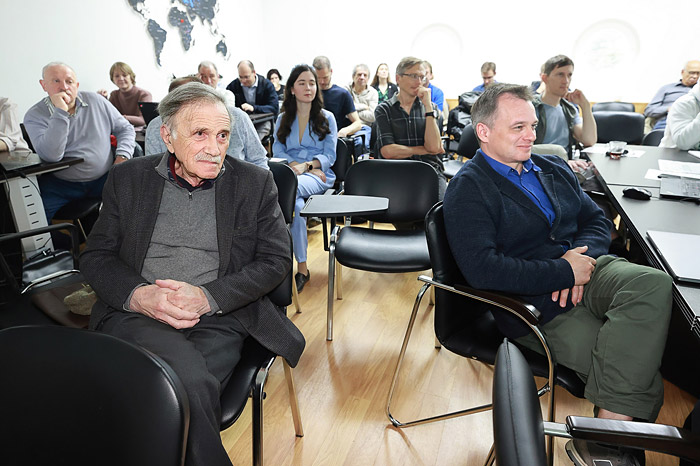
Electronic english version since 2022 |
The newspaper was founded in November 1957
| |
Baikal-GVD: results of the expedition in 2023
From 30 to 2 June, a collaboration meeting of the Baikal-GVD Megascience Project took place at the Laboratory of Nuclear Problems JINR. About 50 scientists participated in the event in-person and online. They discussed the milestones of the last winter expedition aimed at installing two new clusters at the Baikal Neutrino Telescope. In particular, specialists considered the results of improving the reliability of the Telescope and promising results of a new method of temporary time synchronisation of optical modules.
During the expedition 2023 held in February-April, specialists installed two new clusters of the Baikal-GVD Facility. To date, the Baikal Neutrino Telescope consists of 12 operating clusters. Each cluster includes 8-9 vertical strings with 36 optical modules. The effective volume of the facility for detecting cascade events from high-energy neutrinos has reached approximately 0.6 cubic kilometres. At present, all installed almost 3,500 optical modules are involved in a search for astrophysical events.
In addition to the partial modernisation of the already installed clusters during the expedition this year, experts installed 576 optical modules and laid 2 bottom cable lines 7.5 km long.
Before 2030, they are going to install 8-10 more clusters of the Telescope. Thus, they will provide the volume of high-energy neutrino detection from space of about 1 cubic kilometre

Having summed up the results of the last expedition, participants of the event considered proposals relating to the optimisation of technical work on the further development of the project. “In particular, specialists have to choose a location for the next clusters and a route for laying bottom cables. They also need to optimise the production of acoustic modules responsible for the coordinate structure of the detector,” Head of the expedition, Head of the Baikal-GVD Facility (DLNP JINR) Igor Belolaptikov highlighted. Participants of the event discussed tasks for the following expedition, traditionally planned for the winter period, when Baikal will be covered with ice thick enough. “During the future expedition, we will update previously installed clusters. We will also install the 13th cluster, lay a cable along the bottom of Lake Baikal for it, and for the next one, probably. We are going to continue calibrating and adjusting the whole facility. We have already managed to synchronise two modules located about 1.5 km from each other with an accuracy of several nanoseconds,” he said.
The Baikal Neutrino Telescope, a megascience facility aimed at detecting and studying ultrahigh-energy neutrino fluxes from astrophysical sources, was put into operation in March 2021. In total, more than 70 scientists and engineers from nine research centres in Russia, the Czech Republic, Slovakia, and Kazakhstan participate in the project. The Baikal Neutrino Telescope, being under construction, together with IceCube, ANTARES, and KM3NeT, is part of the Global Neutrino Network (GNN) and the most important element of the network in the Northern Hemisphere.
The Telescope has been operating since the installation of the first cluster and is actively collecting physical data. Thus, using it, participants of the project have managed to prove the existence of a neutrino flux of astrophysical nature, previously detected by the IceCube Antarctic Neutrino Telescope. Physical Review D, an authoritative scientific journal, published the first results of the search for astrophysical neutrinos. An article covers the results of measuring a diffuse neutrino flux of cosmic origin. Analysing data obtained for the last four years, scientists have identified 25 candidate events for neutrinos of astrophysical nature. The scientific significance of this result lies in the fact that it proves the existence of cosmic neutrinos and that the parameters of the neutrino flux obtained by two different experiments coincide within the limits of statistical and systematic uncertainties.
www.jinr.ru